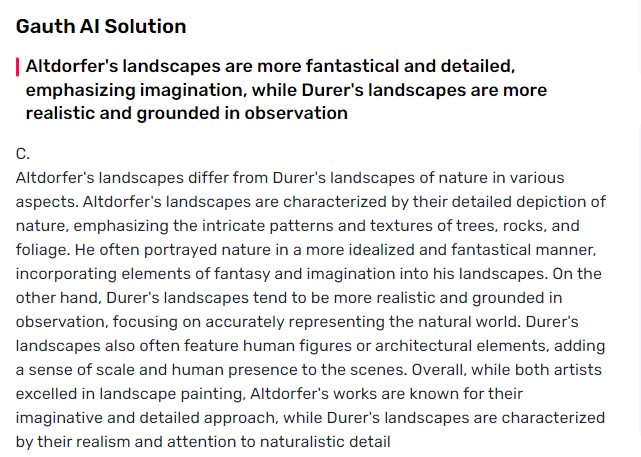The Northern Renaissance saw unimaginable innovation and creativity in the craft. The staggering scene compositions of Albrecht Altdorfer and Albrecht Durer, two noticeable specialists of the time, put them on the map. Though the two experts were gifted at getting nature's greatness, their methods and approaches were out and out interesting.
Altdorfer's scenes are known for their sentimentalism and creative characteristics, while Dürer's works are commended for their authenticity and careful detail. We will compare and contrast how are altdorfer’s landscapes different from durer’s landscapes of nature? in this article so that users can easily differentiate their landscapes of nature.
Distinguishing Altdorfer's Landscapes from Durer's Landscapes of Nature
These factors show how different Altdorfer's Landscapes is from Durer's Landscapes of Nature:
Landscapes by Altdorfer versus Durer's
Altdorfer's Scenes are portrayed by their fantastical and innovative quality. He frequently portrayed scenes of legendary scenes, thick timberlands, and transcending mountains, which were profoundly adapted and loaded up with sensational subtleties. Altdorfer's scenes are wealthy in imagery and summon a feeling of stunningness and marvel in the watcher.
His use of vivacious assortments and diverse brushwork added to the remarkable idea of his organization, giving a sensation of mystery and appeal. Durer's scenes, then again, were more reasonable and zeroed in on precisely catching the regular world. Durer was notable for his capacity to portray nature's many-sided subtleties and fastidiousness precisely.
Atmosphere and Light Treatment
In order to instill a sense of mystery and drama in his paintings, Altdorfer frequently employed dramatic lighting effects. He would utilize striking differentiations of light and shadow to feature specific components in the organization, adding to the general feeling of the show.
Durer, then again, centred more around catching the unpretentious subtleties of light and environment in his scenes. His scrupulousness reached out to the way light played on items and scenes, creating a feeling of authenticity and profundity in his canvases.
Procedure and Style
Another distinctive element among Altdorfer's and Durer's scenes of nature is their method and style. Altdorfer was known for his intense and expressive brushwork, making dynamic and fiery scenes that are loaded up with development and feeling. His use of light and shadow gives his works drama by drawing the eye to particular points of interest and giving the scene depth and atmosphere.
Conversely, Durer's scenes are portrayed by a more fragile and exact strategy, with painstakingly delivered subtleties and an emphasis on authenticity and precision. His utilization of fastidious linework and unobtrusive concealing creates a feeling of surface and profundity in his works, permitting the watcher to see the value in the fine subtleties of the normal world. Durer's scenes exhibit his specialized expertise and dominance of creation, as well as his capacity to catch the quintessence of nature with exceptional accuracy.
Symbolism and Meaning
Ultimately, Altdorfer's scenes and Durer's scenes of nature contrast in their utilization of imagery and basic importance. Altdorfer's scenes frequently contain emblematic components and deeper implications, with figurative figures and otherworldly images that add profundity and secret to his works. His scenes are saturated with a feeling of fantasy and legend, welcoming the watcher to decipher and reveal the secret messages inside the scene.
Then again, Durer's scenes of nature are more clear in their portrayal of the regular world, zeroing in on the magnificence and grandness of the actual scene without the requirement for representative or symbolic components. Durer's scenes convey a feeling of stunningness and marvel at the normal world, permitting the watcher to see the value in the unpredictable excellence of nature without the requirement for deeper implications or complex imagery.
How to Use Gauth for Homework
Here are the steps to use Gauth:
Step 1: Type Your Question
The first step in utilizing Gauth AI is to type your question or query into the designated field. To ensure that the AI accurately comprehends what you are asking, ensure that your input is clear and concise.
Step 2: Get a Solution
The Gauth AI will provide you with a solution or answer based on the data it has been programmed with once you have entered your query. The artificial intelligence will look into your query and come up with a response that tries to answer your specific question or concern.
Step 3: Regenerate or Copy
If you are dissatisfied with the Gauth AI's response, you can enter a different query or question to generate a new response. Alternatively, you can save the provided solution as a copy to use later or to share with others.

Summary
Although both Altdorfer and Durer painted landscapes, their approaches and styles were distinct. Altdorfer's scenes were many times more fantastical and creative, consolidating components like emotional lighting and unusual subtleties. On the other hand, Durer's landscapes were more realistic and focused on accurately portraying the natural world. Altdorfer's scenes stand apart for their unique and creative translations of nature, in spite of the way that the two craftsmen were extraordinary by their own doing.


